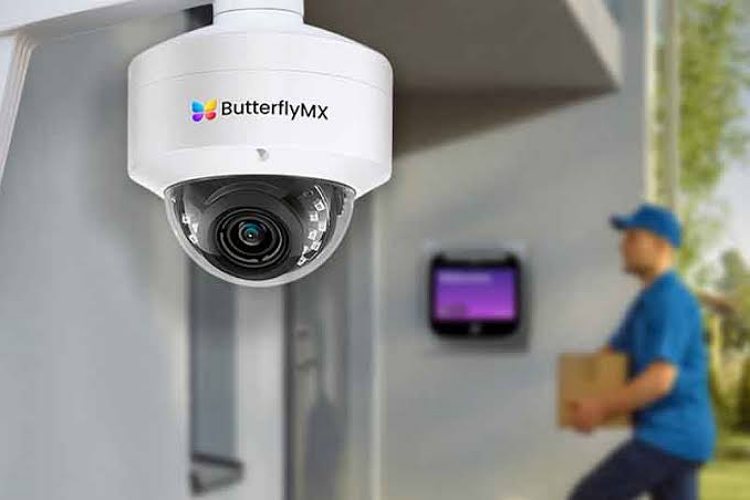 As urban populations rise and multifamily housing becomes the norm for millions of renters, safety has never been more important. Property managers and owners are turning to technology like ButterflyMX to meet modern expectations, and at the center of that shift are building security cameras.
As urban populations rise and multifamily housing becomes the norm for millions of renters, safety has never been more important. Property managers and owners are turning to technology like ButterflyMX to meet modern expectations, and at the center of that shift are building security cameras.
From deterring crime to improving operational oversight, the right camera system can transform the safety and appeal of a multifamily property. In this guide, we’ll break down why multifamily security cameras are essential, how they work, and what to look for in a modern system.
Why security cameras are essential for multifamily buildings
Multifamily buildings face a unique set of challenges when it comes to security. With dozens or even hundreds of people moving in and out each day, it can be difficult to track who’s entering, where they go, and what happens in shared spaces.
Security cameras offer a powerful solution by:
- Deterring crime and vandalism: The presence of cameras alone can prevent unauthorized access and reduce property damage.
- Protecting residents and visitors: Surveillance footage helps document incidents and resolve disputes with reliable evidence.
- Enhancing operational awareness: Building staff can monitor day-to-day activity across the property without being physically present in every space.
- Reducing liability: In the event of an incident, video evidence can be critical in protecting the property owner from legal claims.
Ultimately, security cameras are no longer just a luxury for high-end buildings, they’re an expected feature in any modern multifamily development.
Where to install cameras for maximum impact
A well-designed camera system doesn’t just include more cameras, it includes strategically placed ones. The goal is to maximize visibility in common areas while respecting residents’ privacy.
Here are the most important locations to install building security cameras:
- Main entrances and exits: Capture every person who enters or leaves the building.
- Lobbies and mailrooms: Monitor package deliveries and detect loitering or theft.
- Parking areas and garages: Deter vehicle break-ins and ensure the safety of residents accessing their cars.
- Hallways and elevator bays: Track movement in transition zones and identify patterns during off-hours.
- Amenity spaces: Protect gyms, lounges, rooftops, and pools from misuse or unauthorized access.
Importantly, building managers should always follow local privacy laws and avoid placing cameras in private living areas or anywhere that could capture sensitive activity.
Wired vs. wireless security camera systems
One of the first decisions you’ll need to make is whether to go with a wired or wireless system. Both have pros and cons, especially in multifamily environments.
Wired systems:
- Pros: Stable connection, higher-quality video, less interference.
- Cons: Costly and invasive installation, especially in existing buildings.
Wireless systems:
- Pros: Easier to install, more affordable upfront, better for retrofits.
- Cons: Potential for signal disruption, often relies on strong Wi-Fi infrastructure.
In larger buildings, many property managers choose a hybrid system, hardwiring critical areas and using wireless cameras where flexibility is more important.
What features to look for in multifamily security cameras
Not all security cameras are created equal. Look for a system built specifically for multifamily properties that can scale and integrate with other building technology.
Key features include:
- High-definition resolution: Crisp video quality to identify faces and license plates.
- Night vision: Infrared or low-light cameras to monitor areas 24/7.
- Cloud storage: Easily access footage without the risk of onsite data loss.
- Mobile and remote access: View footage from anywhere via desktop or smartphone.
- Motion detection alerts: Get notified of unusual activity in real time.
- Integration with access control systems: Link video with entry events to monitor who’s coming and going.
The future of property security is smart and integrated
Today’s multifamily properties are adopting tech-enabled solutions to create a seamless living experience. Security cameras are a critical piece of that puzzle, but they’re even more powerful when paired with tools like smart locks, visitor management systems, and intercoms.
As more residents expect smartphone-based living, integrating building security cameras with cloud-based platforms ensures both convenience and peace of mind.
Whether you’re retrofitting an older building or planning a new development, investing in a modern camera system is one of the smartest decisions you can make to boost your property’s value and security.
How to choose the right security camera vendor
Selecting the right vendor is just as important as choosing the right equipment. The vendor you choose should not only offer reliable hardware but also provide excellent support and deep experience working with multifamily properties.
Here are a few things to consider:
- Industry expertise: Look for vendors who specialize in multifamily or commercial buildings, not just residential or small business systems.
- End-to-end service: Choose a provider who can assist with installation, configuration, ongoing maintenance, and software updates.
- System scalability: Make sure their system can grow with your building, especially if you plan to add more units or expand to additional properties.
- Reputation and reviews: Check online reviews and ask for case studies or references to verify performance and customer satisfaction.
A well-chosen vendor will help you design a system that aligns with your building’s layout, resident needs, and long-term goals, making your investment go further.
Final thoughts
As the demand for secure, tech-forward housing grows, multifamily security cameras will continue to be a must-have for competitive properties. By choosing the right system and installing cameras in high-impact areas, property managers can ensure safety, reduce risk, and build trust with their residents.











